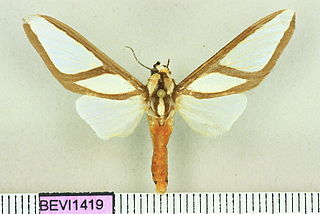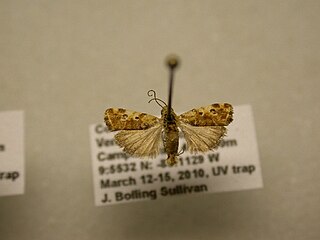
The Cuban macaw or Cuban red macaw is an extinct species of macaw native to the main island of Cuba and the nearby Isla de la Juventud. It became extinct in the late 19th century. Its relationship with other macaws in its genus was long uncertain, but it was thought to have been closely related to the scarlet macaw, which has some similarities in appearance. It may also have been closely related, or identical, to the hypothetical Jamaican red macaw. A 2018 DNA study found that it was the sister species of two red and two green species of extant macaws.
Lepidomys irrenosa is a species of snout moth in the genus Lepidomys. It was described by Achille Guenée in 1852 and is known from the United States, including Florida, Georgia and South Carolina. It is also found on Cuba.
Phyprosopus tristriga is a moth of the family Noctuidae first described by Gottlieb August Wilhelm Herrich-Schäffer in 1868. It is endemic to the Antilles, including Dominica, Cuba and Puerto Rico.

Orodesma apicina is a species of moth in the family Erebidae first described by Gottlieb August Wilhelm Herrich-Schäffer in 1868. The species is found in Florida, Central America and Cuba. It is sometimes recorded in Great Britain through accidental importation in produce.

Elaphria agrotina is a moth of the family Noctuidae first described by Achille Guenée in 1852. It is found from North America, through Central America, the Antilles and Cuba to Brazil and Argentina.
Correbidia terminalis is a moth in the subfamily Arctiinae. It was described by Francis Walker in 1856. It is found from Mexico through Central America and Cuba and Puerto Rico to South America.
Enigmogramma admonens is a moth of the family Noctuidae first described by Francis Walker in 1858. It is found in Brazil, Cuba and Puerto Rico.
Eutelia furcata, the Florida eutelia moth, is a moth of the family Noctuidae. The species was first described by Francis Walker in 1865. It is found from the southern United States to Mexico, Cuba, Puerto Rico and Central America.
Burtia cruenta is a moth in the subfamily Arctiinae first described by Gottlieb August Wilhelm Herrich-Schäffer in 1866. It is found on Cuba.

Robinsonia dewitzi is a moth in the family Erebidae first described by Juan Gundlach in 1881. It is found in Mexico, Costa Rica, Guatemala, Trinidad, Cuba, the Dominican Republic, the Guyanas, Brazil, Venezuela, Paraguay, Peru and Ecuador.

Catabenoides vitrina is a moth of the family Noctuidae first described by Francis Walker in 1857. It is found from California to western Texas and south through Mexico to Central America. It is also found in the Caribbean, including Cuba.
Eunomia insularis is a moth in the subfamily Arctiinae first described by Augustus Radcliffe Grote in 1866. It is found on Cuba.

Spragueia perstructana is a moth of the family Noctuidae first described by Francis Walker in 1865. It is found from the United States, south to the Caribbean and Central America, including Costa Rica.

Composia fidelissima the faithful beauty or Uncle Sam moth is a moth in the family Erebidae. The species was first described by Gottlieb August Wilhelm Herrich-Schäffer in 1866. It is found in southern Florida and the West Indies, including Cuba.
Perasia helvina is a moth of the family Noctuidae first described by Achille Guenée in 1852. It is found in Mexico, Costa Rica and Cuba.
Leucania inconspicua is a moth of the family Noctuidae first described by Gottlieb August Wilhelm Herrich-Schäffer in 1868. It is found in Florida, Cuba, Puerto Rico, Jamaica, the Lesser Antilles and from Mexico to Brazil.
Marimatha obliquata is a moth of the family Noctuidae first described by Gottlieb August Wilhelm Herrich-Schäffer in 1868. It is found on Cuba.
Eublemma recta, the straight-lined seed moth, is a moth of the family Erebidae. The species was first described by Achille Guenée in 1852. It is found in the United States from South Carolina to Florida and west to Texas. It is also found south to Argentina, on Cuba, Jamaica and Puerto Rico.
Syntomeida wrighti is a moth in the subfamily Arctiinae. It was first described by Juan Gundlach in 1881 and is found on Cuba.
Speocropia trichroma is a moth of the family Noctuidae first described by Gottlieb August Wilhelm Herrich-Schäffer in 1868. It is found in Florida and on Cuba.






